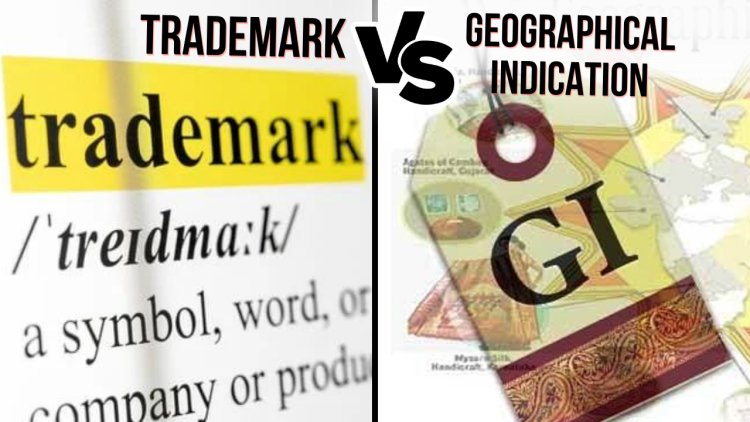Difference between Trademark and Geographical Indication
This article explores the distinctions between trademark registration and geographical indication, two vital components of intellectual property rights. Trademarks protect brand identity, while geographical indications focus on safeguarding products originating from specific regions. The discussion delves into the legal framework, registration processes, ownership rights, applicable legislation, enforcement actions, and overarching goals, offering a comprehensive understanding of their differences. The protection scope and objectives of trademarks and geographical indications are analysed, emphasizing their unique contributions to brand recognition, consumer trust, and regional product promotion. Businesses and consumers are encouraged to comprehend these distinctions for informed decision-making in the realm of intellectual property.

INTRODUCTION
Intellectual properties are a crucial aspect of the business world and come in many types, such as trademark registration, patent, copyright, design registration, geographical indication, and more. Those who are in the business world must be well aware of trademark registration and geographical indication, which are two very important parts of intellectual properties. Although both protect different things, they are distinct in almost all aspects, including their objectives of protection. Therefore, it is crucial to understand the difference between trademark and geographical indication, especially for those who are in the business world. To understand the difference between trademark and geographical indication, it's important to read about each of them individually first.
What is Trademark Registration?
In India, it is important to protect both physical and non-physical assets through legal means. While safeguarding physical assets is relatively easy, protecting intangible assets like trademarks can be more complicated. Trademarks can take the form of symbols, logos or marks that help distinguish a brand. To prevent infringement, it's necessary to register them under the Trademark Act of 1999. This process is called trademark registration. To ensure a smooth registration process, it's important to ensure that your trademark is unique and linked to your business, gather all the required documents, and avoid prohibited marks. It is advisable to hire a trademark lawyer for expert assistance.
What is Geographical Indication?
Geographical indication is defined under section 2(e) of the Geographical Indication of Goods (Registration and Protection Act) of 1999. According to this law, a "geographical indication" for products indicates where those products originate from, such as a specific region or country. This label is used for agricultural or natural products where the quality or reputation of the product is closely linked to its place of origin. For manufactured products, it also applies if some part of the production or processing takes place in the same area.
Key Points of Difference between Trademark and Geographical Indication
It is important to understand the differences between trademark and geographical indication to navigate the world of intellectual property rights. These differences include aspects such as the legal framework, the scope of protection, and the objectives of protection. To obtain a comprehensive understanding of how trademarks and geographical indications differ, we need to look into their registration processes, ownership rights, applicable legislation, enforcement actions, and overarching goals.
Legal Framework
The legal framework is crucial for understanding the differences between trademarks and geographical indications. It includes the definitions provided by the respective acts governing these intellectual property rights. In India, the Trademarks Act, of 1999, and the Geographical Indications of Goods (Registration and Protection) Act, of 1999, outline the legal definitions and provisions for trademarks and geographical indications, respectively. Let us explore how these two laws differentiate between trademarks and Geographical Indications.
· Registration Process: Individuals or companies can protect their unique brand identity and prevent others from using it for their own gain by registering their trademarks with the respective trademark offices in their country. On the other hand, geographical indications are used to identify products that originate from a specific geographic region and are registered collectively by a group or association of producers from that region. This helps to protect the reputation and quality of the products associated with that region and ensures that consumers can trust that they are buying an authentic product.
· Ownership Rights: Trademark rights refer to the legal ownership of a particular brand name, logo, or symbol by an individual or a company. The owner of the trademark has the exclusive right to use it in connection with specific products or services. On the other hand, geographical indication rights are collective rights held by a group of producers or a community from a specific geographical location. These rights aim to protect the unique characteristics and reputation of products that are associated with that particular region.
· Applicable Legislation: Trademark laws, such as the Indian Trademarks Act, of 1999, are put in place to govern the use and protection of trademarks. On the other hand, there are specific laws, such as the Geographical Indication Act, of 1999, which are designed to regulate and safeguard geographical indications. Geographical indications refer to indications that identify goods as originating from a certain region, where a particular quality, reputation, or other characteristic of the good is essentially attributed to its geographical origin.
· Enforcement Actions: If somebody uses a trademark without permission, the owner of the trademark can sue them for trademark infringement. The remedies available to the owner include obtaining temporary or permanent injunctions, damages, and the seizure of goods that are infringing the trademark. To protect their trademark rights, they can initiate legal proceedings. Similarly, legal action can be taken against unauthorized use of geographical indications. The remedies available to the owner may include temporary and permanent injunctions. Nevertheless, the enforcement actions for geographical indications may vary based on the specific laws and regulations governing them. As a result, the remedies sought may differ from those in trademark infringement cases.
Protection Scope
Trademarks protect signs related to goods or services, while geographical indications protect products originating from specific regions and emphasize their qualities.
- Subject Matter: Trademarks safeguard brands, logos, slogans, and other distinct signs of products or services. Geographical indications protect goods from a particular region, where the origin attributes distinct qualities, reputation, or characteristics.
- Geographical Association: Trademarks are not inherently tied to a specific geographic region. However, they may intentionally be associated with certain regions to increase brand value and recognition. Geographical indications, on the other hand, are intrinsically linked to a particular geographical origin.
- Usage Rights: Trademark rights give the owner exclusive use of their mark, preventing others from using similar marks that could cause confusion. Any producer or manufacturer within the protected geographic region can use geographical indications if they meet the defined criteria.
Protection Objective
The objective of protecting trademarks and geographical indications is distinct and reflects their unique purposes and goals. Trademarks are intended to differentiate one entity’s goods or services from others, establish brand recognition, and encourage consumer loyalty. On the other hand, geographical indications are focused on promoting and safeguarding products that possess unique qualities or characteristics attributed to their specific geographic origin. Let's explore how these two objectives differ from each other.
· Brand Differentiation: Trademarks serve as a crucial tool for businesses to differentiate their goods or services from those of their competitors. They are instrumental in creating brand recognition and customer loyalty. On the other hand, geographical indications are designed to promote and safeguard products that possess unique characteristics or qualities specific to their geographic origin. This helps to enhance the reputation of such products and protects them from imitations or counterfeits.
· Consumer Trust: Trademarks are an essential tool for building trust with consumers. They signify a brand's commitment to providing consistent quality and help to identify the source of a product. On the other hand, geographical indications establish a strong link between the product's unique qualities and the reputation of the geographic region it originates from. This link reinforces consumer confidence and ensures that they trust the origin-based attributes of the products they purchase. By leveraging these two mechanisms, brands can establish a strong identity and reputation that resonates with consumers and fosters long-term loyalty.
CONCLUSION
Intellectual Property Rights (IPR) provide a comprehensive framework for safeguarding brands and products. Two such key components are trademarks and geographical indications. While trademarks safeguard brand identity, geographical indications promote products made in a specific region. Businesses and consumers need to understand the legal framework, protection scope, and objectives of these intellectual property rights. By doing so, they can make informed decisions and utilize these rights strategically. Additionally, raising consumer awareness and refining the legal framework can ensure a marketplace that values brand identity, celebrates geographic diversity and fosters consumer trust.












